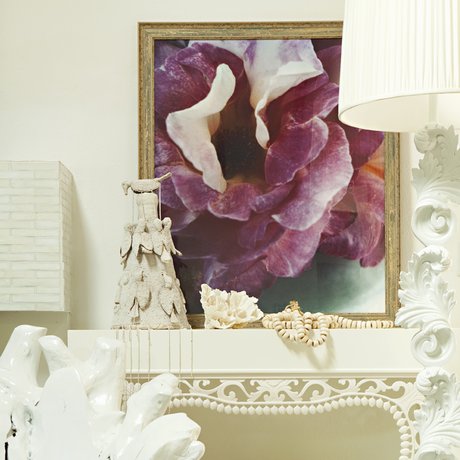This sketch simply shows how best to hang art above a mantel. Keep in mind that scale, balance, proportion and symmetry is key to an uncluttered look, so choose the size of your artwork carefully.
 |
| In this sketch, we are going for a layered effect. This is great for a more traditional look. Here are a few tips to follow if you like this look 1. Start with one big piece that is centered- example above is the large mirror in the background 2. Create movement - example above would be the candlesticks. They are similar objects but varied heights 3. Add visual weight - example above would be the ginger jar. It is large and visually heavier than the other pieces 4. Layer art and photos - Vary the sizes and heights 5. Add accessories of varying heights - example above are the wooden boxes behind the ginger jar In this sketch we are going for a grid layout of the art on the wall. this look is appropriate in contemporary or transitional decor. If you like this look, keep in mind that you will need to keep the objects on the mantle fairly clean and simple. Don't add too many layers. Here we just added a couple of ginger jars. Varying the sizes is very important to add movement. We also added a wooden box in the center to anchor the art work, otherwise they will seem to visually float on the wall. And finally we added a floral arrangement - faux orchids work very well for this purpose. They are clean and simple and a good quality faux arrangement looks very real. In this sketch, we are going for a cleaner look as well....not alot of layering. Here we added a mirror, hung horizontally and a smaller round mirror for visual appeal. Then we added a small box and a faux floral arrangement. In this sketch, we are going for a salon style of hanging art and photos. This is a great look for an eclectic, traditional or shabby chic decor. Salon style should have a "collected" feel and very casual. There should be various heights, sizes, frames and finishes to make this look authentic. It should still have order and symmetry. Not much else is needed on the mantel with this look. A lot of folks like to use family pictures on their mantels, which is great, as long as you vary the sizes and add other objects. Limit the pictures to just a few. Pictures can be framed and hung above the mantel if you must display them all Sketches done using Dream Draper Here are a few examples taken from various sources on the internet The decorating of your mantel should represent your style, so go with what you love and things you enjoy looking at all the time. Here are some fun accessories that are definitely mantel worthy.
Hope you have been inspired to take on this challenge. If all else fails, then contact us and we can help you get your mantel model home ready at Casa Vilora Interiors
Be inspired,
Veronica Solomon, IDS, CID
|

.jpg)



















.jpg)
.jpg)








.jpg)